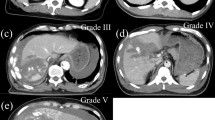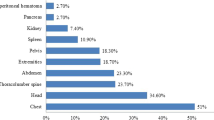Abstract
Introduction
Some case series have reported that hepatectomy was used to treat major bile leakage and biloma. However, it is unknown whether non-operative management (NOM) can be used to treat these complications. Our hospital uses NOM primarily for blunt liver injuries. This study describes the incidence and treatment of newly developed biloma in hemodynamically stable patients with blunt liver trauma and investigates NOM as a treatment option.
Methods
A retrospective chart review was conducted from January 2006 to May 2012 at a tertiary care hospital in Japan. The primary outcome measures were the incidence of biloma and the number of patients who required operative management. Biloma was defined as a cystic lesion with low density near the site of liver injury on contrast-enhanced abdominal computed tomography.
Results
Chart review identified 98 patients (63 males and 35 females). Thirty-five of 98 patients (35.7 % [95 % CI, 26.2–45.2]) developed biloma. Infected biloma in three, of whom one required percutaneous drainage. Hepatectomy was not performed.
Conclusion
Our data suggest that biloma after NOM of blunt liver injury is common (36 %), but infected biloma is rare. All patients with bilomas were treated using NOM. Most bilomas are self-limited, and NOM is feasible.


Similar content being viewed by others
References
Malhotra AK, Fabian TC, Croce MA et al (2000) Blunt hepatic injury: a paradigm shift from operative to nonoperative management in the 1990s. Ann Surg 231:804–813
Cachecho R, Clas D, Gersin K et al (1998) Evolution in the management of the complex liver injury at a level I trauma center. J Trauma 45(79–8):2
Kurashiki City website population. http://www.city.kurashiki.okayama.jp/dd.aspx?itemid=32052#itemid32052
Baker SP, O’Neill B, Haddon W Jr et al (1974) The injury severity score: a method for describing patients with multiple injuries and evaluating emergency care. J Trauma 14(187–19):6
Moore EE, Cogbill TH, Jurkovich GJ et al (1995) Organ injury scaling: spleen and liver (1994 revision). J Trauma 38:323–324
Pachter HL, Spencer FC, Hofstetter SR et al (1992) Significant trends in the treatment of hepatic trauma. Experience with 411 injuries. Ann Surg 215:492–500 discussion 500-492
David Richardson J, Franklin GA, Lukan JK et al (2000) Evolution in the management of hepatic trauma: a 25-year perspective. Ann Surg 232:324–330
Goffette PP, Laterre PF (2002) Traumatic injuries: imaging and intervention in post-traumatic complications (delayed intervention). Eur Radiol 12:994–1021
Boone DC, Federle M, Billiar TR et al (1995) Evolution of management of major hepatic trauma: identification of patterns of injury. J Trauma 39:35–344
Fabian TC, Croce MA, Stanford GG et al (1991) Factors affecting morbidity following hepatic trauma. A prospective analysis of 482 injuries. Ann Surg 213:540–547 discussion 548
Croce MA, Fabian TC, Menke PG et al (1995) Nonoperative management of blunt hepatic trauma is the treatment of choice for hemodynamically stable patients. Results of a prospective trial. Ann Surg 221:744–753 discussion 753-745
Kozar RA, Moore FA, Cothren CC et al (2006) Risk factors for hepatic morbidity following nonoperative management: multicenter study. Arch Surg 141:451–458 discussion 458-459
Giss SR, Dobrilovic N, Brown RL et al (2006) Complications of nonoperative management of pediatric blunt hepatic injury: diagnosis, management, and outcomes. J Trauma 61:334–339
Hsieh CH, Chen RJ, Fang JF et al (2003) Liver abscess after non-operative management of blunt liver injury. Langenbeck’s Arch Surg (Deutsche Gesellschaft fur Chirurgie) 387(343–34):7
Anand RJ, Ferrada PA, Darwin PE et al (2011) Endoscopic retrograde cholangiopancreatography is an effective treatment for bile leak after severe liver trauma. J Trauma 71(480–48):5
Bridges A, Wilcox CM, Varadarajulu S (2007) Endoscopic management of traumatic bile leaks. Gastrointest Endosc 65(1081–108):5
Lubezky N, Konikoff FM, Rosin D et al (2006) Endoscopic sphincterotomy and temporary internal stenting for bile leaks following complex hepatic trauma. Br J Surg 93(78–8):1
Acknowledgments
The authors are grateful to Dr. John A Ward for scientific review of this article and Ms. Ryoko Ono for editing the figures.
Conflict of interest
None to declare.
Author information
Authors and Affiliations
Corresponding author
Rights and permissions
About this article
Cite this article
Tamura, N., Ishihara, S., Kuriyama, A. et al. Long-Term Follow-Up After Non-operative Management of Biloma Due to Blunt Liver Injury. World J Surg 39, 179–183 (2015). https://doi.org/10.1007/s00268-014-2780-z
Published:
Issue Date:
DOI: https://doi.org/10.1007/s00268-014-2780-z




